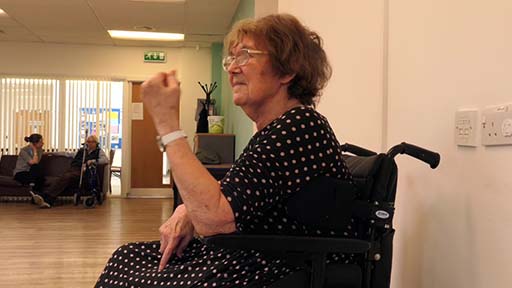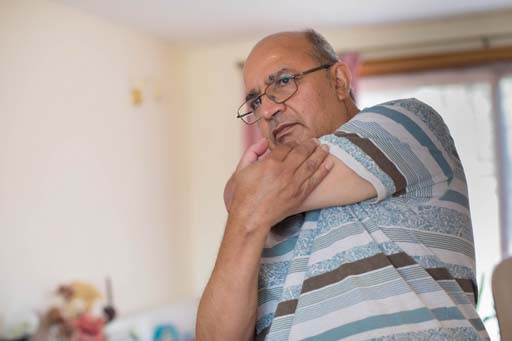2.5 Helping to manage stiff, rigid or frozen muscles
Simple movements, such as getting up from a chair, rolling over in bed, moving fingers to write or fastening a button can be difficult, frustrating and sometimes painful for someone with Parkinson’s. Stiff and painful joints, especially shoulders, are common.
There are two types of rigidity:
- ‘lead pipe’, when both arms and legs are very rigid and held quite tightly to the body
- ‘cog wheel’, characterised by a clicking feeling as the limb is being bent – it feels like a cog wheel moving round.

Transcript
This lady has fluctuating rigidity as part of her symptoms of Parkinson’s. She has been asked to move her arm up to her shoulder and back down to a resting point as part of a series of exercises. At first, you can see that she moves her arm quite freely. She is able to complete the full range and motion of the movement. But the longer the exercise goes on, you can start to see that her movement becomes slower. She is finding it harder to complete the full range and movement of the exercise. And that is due to the rigidity that is starting to impact on her arm movements.
You can download this resource and view it offline. It may be useful as part of a group activity.
It is important to check if the person you are caring for is taking or needs pain relief for these symptoms. If you think they do need pain relief, report this to your manager. Generally the person’s GP or Parkinson’s nurse will be able to prescribe adequate and appropriate medication. If this does not help, they may need to see their specialist.
Further information is available in the Parkinson’s UK information sheet on pain [Tip: hold Ctrl and click a link to open it in a new tab. (Hide tip)] .
People with Parkinson’s can experience problems with facial expression because of difficulty controlling stiff facial muscles. Sometimes people may make expressions that they didn’t plan to make, or they find it difficult to smile or frown. This can make it hard to express how they feel about a situation or something that another person has said. It can also affect people’s confidence in social situations. We automatically read people’s faces and respond appropriately. When you are talking to someone with Parkinson’s remember to be aware that they may be feeling differently from how they look.
Freezing
Some people with Parkinson’s will suddenly freeze when making a movement like walking. Freezing often happens when something interrupts or gets in the way of a sequence of movements. Many people with Parkinson’s describe freezing as times when their feet feel ‘glued to the ground’. They might not be able to move forward again for several seconds or minutes.
Some people may feel like their feet are ‘frozen’ or stuck, but that the top half of their body is still able to move. They might freeze when they start to walk or when they try to turn around. But freezing does not just affect walking – some people freeze during speaking or during a repetitive movement, like writing or brushing their teeth.
Freezing can get worse if a person is worried, in a place they don’t know or if they lose concentration. Not knowing if and when you might freeze can cause anxiety for people and have an impact on what social activities they choose to do. If a person has trouble starting a movement, this is sometimes called ‘start hesitation’. They might freeze when trying to step forward just after standing up, or when they lift a cup to drink, when they start to get out of bed.
‘I can walk so much better on these paving slabs because I can judge my stride. If every floor was made like this I'd be delighted...I don't even have to use my stick.’
Freezing can also happen with thought. Some people find this when they are trying hard to remember something in particular, for example trying to remember names.
Where and when it can happen
People with Parkinson’s are most likely to freeze when they are walking, as walking is a series of individual movements that happen in a particular order. If one part of the sequence is interrupted, the whole movement can come to a stop.
People are also more likely to freeze when walking towards doorways, turning or changing direction, in crowded places, or when their medication isn’t working very well. It’s more likely to happen if a person has had Parkinson’s for some time, and if they have been taking levodopa drugs for a number of years. But freezing can be experienced by people who are not taking levodopa, so it is not just a side effect of medication.
Is freezing the same as going ‘off’?
Freezing is not the same as being ‘on’ or ‘off’ When a person's symptoms are well controlled, this is known as the 'on' period, which means that medication is working well. When symptoms return, this is known as the 'off' period.
There are different ways of managing freezing and ‘on/off’ ‘periods’, so they must be seen as separate problems. During ‘off’ periods, people with Parkinson’s will hardly be able to move at all, so walking, going upstairs or reaching for a cup will be difficult. When people freeze, it only affects certain movements, so they may not be able to walk, but can still reach for a cup. We will revisit ‘on/off’ in Section 4.
Treating freezing
Treatments for freezing may include changes to a person’s medication regime, occupational therapy and physiotherapy. You may be one of these therapists or you may be able to ask for a referral to them. Deep brain stimulation may also help some people.
Techniques to help people experiencing freezing
There are some methods that can ‘cue’ people to trigger them to move again. You may be able to improve someone’s mobility and reduce anxiety by introducing cueing techniques. These are listed in our information sheet Freezing in Parkinson’s.
Find out more in the Parkinson’s UK freezing information sheet.
Actions to take
Find out if the person has any problems with freezing by observing them or asking them. If they do, report the problem to your manager. They may need changes to their medication or they may benefit from seeing a physiotherapist.
- For some people it is the start of a movement that is hard, such as taking the first step to walk. A physiotherapist can give tips to help with this and advise on ‘cues’.
- These can include counting steps and using trigger words to encourage movement.
- If you notice the person with Parkinson’s you care for is regularly freezing, you can arrange a medication review with their GP, specialist or Parkinson’s nurse.
- Make sure the person is receiving their medication on time, every time. (You will learn more about the importance of medications management in Section 4.)
- Encourage people to engage in regular physical activity, especially as evidence shows that increasing exercise can help improve symptoms. This can help to strengthen muscles, increase mobility in their joints and build up their general fitness and health.
2.4 Helping to manage tremor

